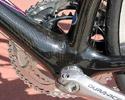
Recently on Cyclingnews.com |
Tech Feature: February 16, 2007
T-Mobile bike set up on track
On Wednesday, Team T-Mobile set up and tested their Giant time trial bikes at the ADT Event Center Velodrome in Carson, California. Giant also announced they will make and sell a new road bike, in limited quantities. The new bike is the TCR Advanced Team T-Mobile edition, made for the public with copious input from the T-Mobile riders of seasons past. Mitch Friedman was on hand to talk with T-Mobile riders Michael Barry and Michael Rogers about their new bikes and bike setup.

|
Most notable about the new bikes are the stiffer bottom brackets, something all the T-Mobile riders wanted. The limited edition production road bike reflects the pros' wishes. Overall, the bike is about 15% stiffer then other past bikes. In creating this design, Giant had to ensure that the stiffer bottom bracket would not give a harsh ride. They accomplished this by removing some of the material from the down tube and top tube to soften the ride without sacrificing handling capabilities.
The bike weighs about the same as last year's bike but is much stiffer at the bottom bracket and chainstays because the stays are beefier now. Also new is the integrated seat post, the first on a mass production bike for the US despite its prevalence in Europe for the past few years.
So why the integrated seat post? It saves about 40 grams over a regular seat post and once set up, it will never slide down like a normal seat post sometimes will. However, one obvious drawback is that once the bike is set up for a rider, it is set up for that rider only. About 2 cm of seat adjustability is possible, but that is only good for small changes, such as those due to a rider swapping cleats or shoes or seat padding. The integrated seat post is also stiffer then a round, separate seat post. The stiffer bottom bracket and stays and the stiffer seat post make the road bike good sprinters' bikes.

|
Michael Barry and Michael Rogers were on hand testing and tweaking the setup of their time trial bikes just days before the Tour of California begins.
When asked how he liked riding his road time trial bike on the track, Barry responded jovially, "It's not too bad, really. I did a lot of track riding before, but I have the brakes to slow down. That's the big difference. The time trial bikes have a lower bottom bracket and the cranks are longer so you have to think about that a bit on the banking when going slowly."
Barry explained the advantages of setting up his bike on a track instead of on the road or a wind tunnel. "Well everything is static here, so the wind is not a variable. You can just make changes. Everything has to be the same when you make one change so being indoors...it's a bit better. I think it [the track] is beneficial over a wind tunnel, because in a wind tunnel, you can get the lowest drag but it might not mean you can generate a good amount of power--which we are learning here. The lower I was going [aerodynamically], the less drag I had, but I could not generate the same power."

|
Rogers confirmed Barry's thoughts on the pros of setting up his TT bike on the velodrome. "There are controlled conditions here. At an indoor track, there are no major winds and changes in conditions, so the data is more accurate. We have a very sophisticated power-measuring system. We can see the smallest changes."
Rogers has experience with this approach to setup. "This is the fourth or fifth time [I've done this kind of thing], but I have never done it here in the States. It's getting better and better over the years."
However, he still sees the value in taking his bike to the wind tunnel. "The wind tunnel gives you a very good study of position when you are in your real position and in race-like conditions producing the same amount of effort. In race-like conditions, it's more acute.

|
When asked how he felt going into the Tour of California, Rogers said, "Yeah, good good. You know, I think I'm pretty well prepared this year--definitely better than last year. There will be some stiff competition, and I think the American guys are really motivated. I have a good team here so my spirits are good. I think I [will] give it my best."
Despite all the testing, Rogers doesn't expect the new bike and tweaked position to help him much for the prologue in San Francisco. "With that hill, you just need legs. That's a hard prologue."
The price tag on this new Giant TCR Advanced Team T-Mobile bike is US$6,000. About 200 of the bikes are now available through bike shops.
Photography
For a thumbnail gallery of these images, click here
Images by Mitch Friedman/www.mitchophoto.com
- GIANT TCR Advanced T-Mobile bike
- GIANT TCR Advanced T-Mobile bike
- The bike's bottom bracket of the bike was stiffened.
- Chainstays of the bike were beefed up.
- Seat post
- Michael Rogers and Michael Barry check things out on the computer.
- Michael Rogers on the velodrome on a road time trial bike.
- Michael Barry on the velodrome
- Michael Rogers
- Michael Barry and Michael Rogers
- Michael Rogers up high on the banking. Does he want to do a flying 200m?
- Michael Rogers
- Michael Rogers
- Michael Barry hangs out
- Michael Barry on the velodrome
- Strike a pose Michael Barry

